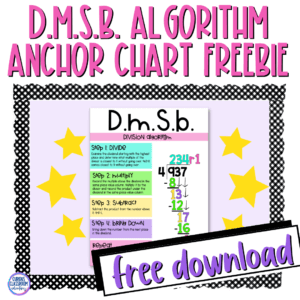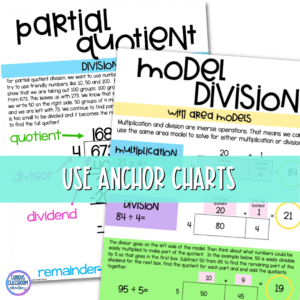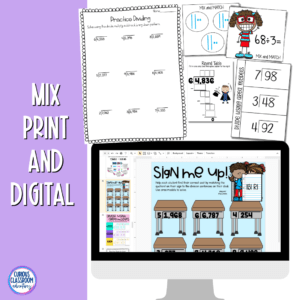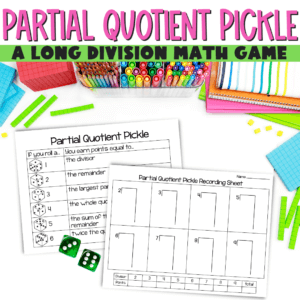Long division can be a tough concept for fourth graders to grasp. However, with the right strategies in place, it can be a breeze! In this blog post, we’ll go over three different strategies for how to teach long division to fourth graders. By the end of this post, you’ll have everything you need to differentiate for learning styles and make long division fun and easy for your students!
Strategy #1: Teach Long Division with Area Models
One great strategy for teaching long division is using area models. Area models are especially helpful because they provide a concrete way for students to visualize the division process. To use this strategy, start by drawing a rectangle on the board. Then, the divisor goes on the left side of the model. Next, think about what numbers could be easily multiplied to make part of the quotient. In the example below, 50 is easily divisible by 5 so that goes in the first box. Subtract 50 from 95 to find the remaining part of the dividend for the next box. Find the quotient for each part and then add the quotients together.
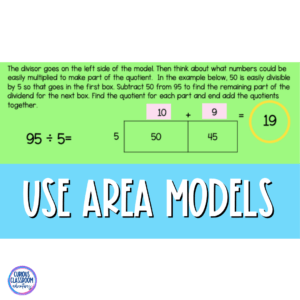
Strategy #2: Teach Long Division with Partial Quotients
Another strategy that can be used to teach long division is called partial quotients. This strategy is helpful because it breaks the division process down into smaller steps that are easier for students to understand. For partial quotient division, we want to use numbers that are easy to work with, so we try to use friendly numbers like 10, 50, and 100.
First, we write 100 on the right side to show that we are taking out 100 groups. 100 groups of 4 make 400, so we subtract 400 from 673. This leaves us with 273. We know that we can make at least 50 more groups, so we write 50 on the right side. 50 groups of 4 make 200, so we take 200 away from 273 and we are left with 73. We continue to find partial quotients until the remaining dividend is too small to be divided and it becomes the remainder. Finally, add the partial quotients to find the full quotient. My favorite way to have students practice this strategy is with the game Partial Quotients Pickle…having to decide where to put numbers so they come out on top, will leave your kids in a pickle for sure!
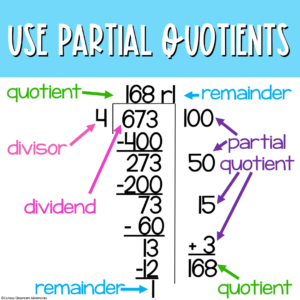
Strategy #3: Teach Long Divison with the Standard Algorithm
The standard algorithm (a.k.a. DMSB) is a tried-and-true method for teaching long division. This method is beneficial because it is relatively simple and straightforward once students get the hang of it.
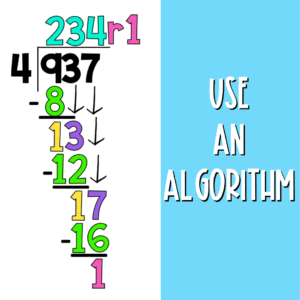
D: divide
Examine the dividend starting with the highest place and determine what multiple of the divisor is closest to it without going over. 4×2=8 comes closest to 9 without going over.
M: multiply
Record the multiple above the dividend in the same place value column. Multiply it by the divisor and record the product under the dividend in the same place value column.
S: subtract
Subtract the product from the number above it. 9-8=1.
B: bring down
Bring down the number from the next place in the dividend.
Repeat these steps until there are no more numbers to bring down and the divisor’s remaining dividend is too small to be divided. Grab your free copy of the DMSB anchor chart right here!
The road to mastering long division can seem long and bumpy at times, so here are a few helpful tips to make it easier, for you and your students!
Use Anchor Charts.
Anchor charts are a visual way to introduce a concept to your students. They’re also great for reference throughout a unit or lesson! You can grab your set of anchor charts that can be used when introducing long division to fourth graders right here! All three of the strategies above are included as well as some extras like using place value blocks and estimating quotients.
Keep it Fresh by Mixing Print and Digital Lessons.
No one likes to do the same old thing every day. Add a little novelty to your lessons by rotating some technology-based lessons throughout the unit. These two division units coordinate with each other so the transition between paper-and-pencil on a desk or drag-and-drop on a desktop is seamless for your students.
Let kids play with division using cooperative learning or partner games.
These partner games and cooperative tasks are great for giving fourth-grade students extra practice with long division! In these downloads, students will get plenty of practice breaking down dividends and divisors as well as finding quotients using all three strategies described above.
There you have it—everything you need to know about teaching long division to fourth graders! By using area models, partial quotients, or standard algorithm strategies along with anchor charts and practice sheets or games, your students will be mastering long division in no time at all!
Ready to read more? Check out this blog on how I structure my 90-minute math block!


